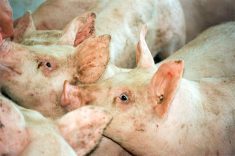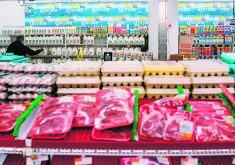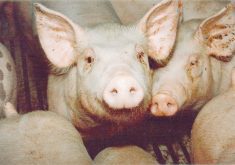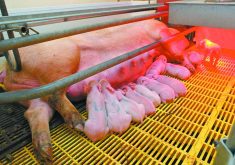The U.S. growth in production is not keeping pace with exports, and analyst warns of a price correction
CALGARY — China and the United States are both increasing hog production, and that has major implications for the Canadian pork industry, says an agricultural analyst.
Brett Stuart, chief executive officer of Global AgriTrends in Denver, predicts that China will add 1.7 million tonnes of pork production next year and reduce its imports as a result.
At the same time, the U.S. is building new hog barns and processing capacity, the latter reaching 46,500 head per day by 2018. Americans expect to export more pork, but it isn’t clear where that export market will be.
Read Also

Crop quality looks good this year across Prairies
Crop quality looks real good this year, with the exception of durum.
Stuart, a former lead economist for the U.S. Meat Export Federation who presented a global outlook at the Alberta Pork annual meeting Nov. 9, said following production problems two years ago that caused pork shortages, hog production became profitable in China last year, and profits there are tax free. Nobody knows how many pigs are in China, but money will drive expansion.
“At one hundred bucks a head, you’ll put a sow in the bedroom,” said Stuart, in reference to reports that people raise pigs in apartment buildings in China if there is money to be made.
A one-third reduction in China’s pork imports amounts to about 650,000 tonnes, said Stuart. The country imported large amounts of pork this year, but that level is unlikely to be matched next year.
“We face some major risk from this China bubble,” Stuart said.
As for America, the U.S. Department of Agriculture predicts pork production will rise in 2017, but per capita consumption in the U.S. is not expected to increase.
Neither are pork exports to any great degree.
“When I’m saying we’re going to have four to five percent production growth, I’m also saying we’re going to have .7 percent export growth. And you’ve got to export five percent more for every one percent of production increase,” said Stuart. “We are not keeping pace with exports next year. I don’t know where we can find a market to absorb this. We are looking over the edge of a cliff in the hog markets.”
Stuart said he believes there is a 50-50 chance of a major correction in December hog futures as the market reacts to excess slaughter capacity but limited export outlets.
In Canada, the pork industry is showing minor expansion, but its export growth of late has all been to China, and now China may be importing less. Stuart said Canada runs the risk of evolving into a piglet supplier to U.S. feeders and packers unless it secures profitability for producers on finished pork.
While the U.S. focuses on chain speed, Canada could differentiate itself and increase exports by catering to niche markets. That way it would avoid head-to-head competition with the U.S. hog production juggernaut.
He also said Canada is in a better position than the U.S. to make bilateral trade deals. Brexit might prove an ideal opportunity to increase exports, he added.
“Pull them aside and cut a deal,” he said of the United Kingdom.
“You may get something much better … and Britain is a fantastic pork market.”
Alberta Pork chair Frank Novak said the prospect of cheap U.S. pork imports isn’t new.
“We’re living it,” he said.
While American hog producers are buying into processing plants and working toward more vertical integration, that isn’t the trend in Canada.
“The critical difference between the U.S. and Canada now is, in the U.S. producers are taking a thing that we read about once, called profits, and they’re using that money to invest in processing because they know they have to. They don’t necessarily want to.
“In Canada, unfortunately, we’re going the other way. We have vertical integration happening but in some cases it’s happening be-cause processors are buying producers who have gone out of business.”


















